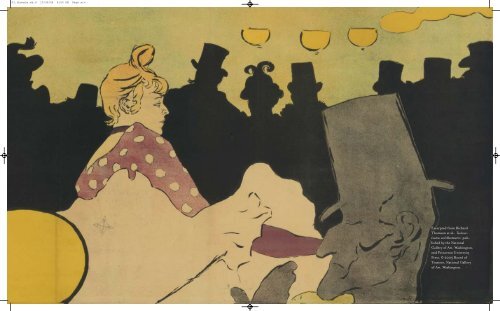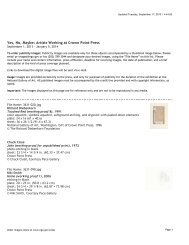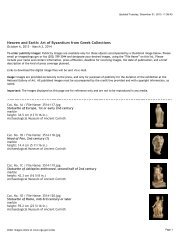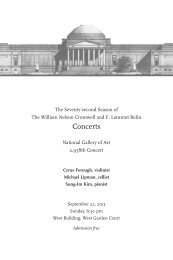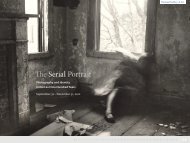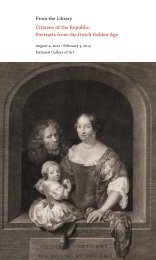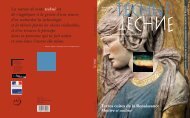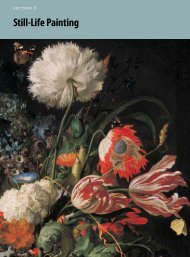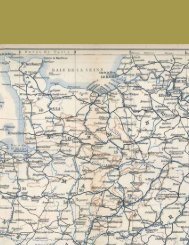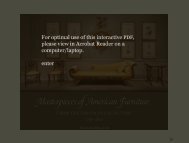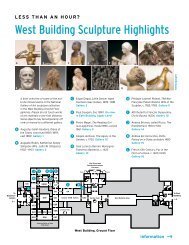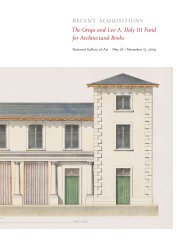Excerpted from Richard Thomson et al., Toulouse- Lautrec and ...
Excerpted from Richard Thomson et al., Toulouse- Lautrec and ...
Excerpted from Richard Thomson et al., Toulouse- Lautrec and ...
You also want an ePaper? Increase the reach of your titles
YUMPU automatically turns print PDFs into web optimized ePapers that Google loves.
01.thomson.ws.4 10/26/04 4:00 PM Page xiv<br />
<strong>Excerpted</strong> <strong>from</strong> <strong>Richard</strong><br />
<strong>Thomson</strong> <strong>et</strong> <strong>al</strong>., <strong>Toulouse</strong>-<br />
<strong>Lautrec</strong> <strong>and</strong> Montmartre, published<br />
by the Nation<strong>al</strong><br />
G<strong>al</strong>lery of Art, Washington,<br />
<strong>and</strong> Princ<strong>et</strong>on University<br />
Press, © 2005 Board of<br />
Trustees, Nation<strong>al</strong> G<strong>al</strong>lery<br />
of Art, Washington.
01.thomson.ws.4 10/21/04 10:17 AM Page 2<br />
<strong>Richard</strong> <strong>Thomson</strong><br />
<strong>Toulouse</strong>-<strong>Lautrec</strong> & Montmartre:<br />
Depicting Decadence in Fin-de-Siècle Paris<br />
The philosophy of vice that he som<strong>et</strong>imes flaunts with<br />
provocative ostentation nevertheless takes on, because of<br />
the strength of his drawing <strong>and</strong> the gravity of his<br />
diagnosis, the instructive v<strong>al</strong>ue of a clinic<strong>al</strong> class in mor<strong>al</strong>ity.<br />
Gustave Geffroy, La Justice, 1893<br />
÷e hub of Henri de <strong>Toulouse</strong>-<strong>Lautrec</strong>’s carÕr was Montmartre. It was on those sloping<br />
strÕts to the north of Paris’ m<strong>et</strong>ropolitan center that he trained in the studio of Fern<strong>and</strong><br />
Cormon during the early <strong>and</strong> mid-1880s. It was in that quartier that he had his studios,<br />
first in the rue Caulaincourt <strong>and</strong> then in the rue Frochot. Montmartre was where he made<br />
his first artistic Ïiends, initi<strong>al</strong>ly fellow southerners finding their fÕt in the capit<strong>al</strong> such<br />
as Henri Rachou <strong>and</strong> François Gauzi, then more radic<strong>al</strong> individu<strong>al</strong>s like Louis Anqu<strong>et</strong>in<br />
<strong>and</strong> Emile Bernard as well as the intense Dutchman Vincent van Gogh. At the cabar<strong>et</strong>s<br />
of Montmartre <strong>Lautrec</strong> learned the vocabularies of innovation <strong>and</strong> disruption that would<br />
underlie much of his art. ÷e Chat Noir’s shadow plays taught him the expressive force<br />
of the silhoueıe, while the obstreperously anti-establishment v<strong>al</strong>ues of its performances<br />
<strong>and</strong> songs <strong>al</strong>erted him to the younger generation’s reading of the decadence of contemporary<br />
life <strong>and</strong> schooled him in a satiric<strong>al</strong> approach to it. At Aristide Bruant’s cabar<strong>et</strong>,<br />
the Mirliton, <strong>Lautrec</strong> made his first contact with a rising “star” of the Montmartre entertainment<br />
industry, absorbing the low-life atmosphere <strong>and</strong> the griÛ natur<strong>al</strong>ism used<br />
to describe it. It was the stimulus of the complex subcultures of Montmartre that provided<br />
the subjects of many of <strong>Lautrec</strong>’s early exhibition paintings. And they in turn led to<br />
commissions for posters, images such as Moulin Rouge: La Goulue <strong>and</strong> Ambassadeurs: Aristide Bruant<br />
(sÕfigs. 10 <strong>and</strong> 113), which not only made an indelible impact on this new medium,<br />
so hitched to the momentum of the modern world, but <strong>al</strong>so gave <strong>Lautrec</strong> an impressive<br />
<strong>and</strong> lasting reputation.<br />
montmartre <strong>and</strong> the “decadent” republic<br />
<strong>Lautrec</strong>’s Montmartre years loosely fit the decade 1885 to 1895, <strong>and</strong> it is on this span that<br />
the present exhibition concentrates.⁄ It takes us Ïom <strong>Lautrec</strong>’s emergence as a mature<br />
artist aÓer sever<strong>al</strong> years of academic training in the teaching ateliers of Léon Bonnat <strong>and</strong><br />
then Cormon, to the mid-1890s when, with new Ïiends among the Nabi circle of artists<br />
<strong>and</strong> the writers of La Revue blanche, <strong>Lautrec</strong>’s work shiÓed upmark<strong>et</strong> to the theater <strong>and</strong> ciÙ<br />
center bars. It can be argued that 1885–1895 o°ers the best period of <strong>Lautrec</strong>’s short<br />
carÕr. His work was of consistently high qu<strong>al</strong>iÙ, he covered his widest range of subjects,<br />
2<br />
|d<strong>et</strong>ail|<br />
Henri de <strong>Toulouse</strong>-<strong>Lautrec</strong>,<br />
Moulin Rouge: La Goulue, 1891<br />
(fig. 10)<br />
|1|<br />
Pilotell [Georges Labadie],<br />
“Seize those Cannons,” 1871,<br />
h<strong>and</strong>-colored lithograph,<br />
27.3 x 19.3 cm. Victoria & Albert<br />
Museum, London, E.1075-1962<br />
<strong>and</strong> he was at his most experiment<strong>al</strong> with di°erent<br />
media. It is <strong>al</strong>so the phase of his carÕr in which his art<br />
engaged most intricately with contemporary socieÙ.<br />
÷is was, specific<strong>al</strong>ly, Montmartre. To hyperbolize<br />
about <strong>Lautrec</strong> as the quintessenti<strong>al</strong> chronicler of the<br />
belle époque is to exaÎerate. Living in, <strong>and</strong> taking<br />
most of his subjects Ïom, a defined quartier of Paris,<br />
<strong>Lautrec</strong> focused his art on its soci<strong>al</strong> geography, subcultures,<br />
<strong>and</strong> loc<strong>al</strong> economy. But this is not to say that<br />
<strong>Lautrec</strong> approached Montmartre like some systematic<br />
sociologist or anthropologist. He was an artist, working<br />
by instinct, aıracted to what caught his eye. ÷us<br />
he made particular choices for his work, even developed<br />
particular speci<strong>al</strong>ities. <strong>Lautrec</strong> was a soci<strong>al</strong> painter,<br />
then, but we nÕd to define this further. ÷us we will<br />
explore the aspects of contemporary socieÙ with which<br />
<strong>Lautrec</strong>’s work interacted, examine the visu<strong>al</strong> culture<br />
of Montmartre, <strong>and</strong> assess <strong>Lautrec</strong>’s images <strong>al</strong>ongside<br />
those of others. ÷is is in contrast to a strictly<br />
biographic<strong>al</strong> angle, which might emphasize <strong>Lautrec</strong> the<br />
aristocrat, the h<strong>and</strong>icapped, the <strong>al</strong>coholic.¤ ÷e objective<br />
here is to explore the moderniÙ of <strong>Lautrec</strong> <strong>and</strong><br />
how it was formed by soci<strong>al</strong> <strong>and</strong> cultur<strong>al</strong> circumstances.<br />
3 · <strong>Toulouse</strong>-<strong>Lautrec</strong> & Montmartre · <strong>Richard</strong> <strong>Thomson</strong><br />
Born in 1864, <strong>Lautrec</strong> lived his formative<br />
<strong>and</strong> profession<strong>al</strong> years during the early decades of<br />
the ÷ird Republic. ÷e republic had bÕn born in<br />
1870 Ïom disaster, with the collapse of the preceding<br />
regime, the Second Empire of Napoleon iii, in<br />
the face of German invasion. ÷e new republic was<br />
conÏonted within its first few months with both<br />
negotiating a humiliating peace with the now united<br />
German Empire <strong>and</strong> repressing a Ïatricid<strong>al</strong> civil war,<br />
for the lower-class population of Paris, which had<br />
doÎedly withstood a siege throughout the biıer winter<br />
of 1870–1871, was riled by the new government’s conservative<br />
complexion <strong>and</strong> concessions to the Germans.<br />
Its insurgent Commune, of which Montmartre had<br />
bÕn a center, was fiercely put down by the republic’s<br />
troops in “Bloody WÕk” of May 1871, which leÓ some<br />
25,000 Parisians dead (fig. 1). ÷e ÷ird Republic<br />
had dÕp flaws. During the 1870s when <strong>Lautrec</strong> was<br />
a schoolboy, conservative politicians came close to<br />
r<strong>et</strong>urning France to monarchy. It was only in 1879<br />
that a genuine republican, Jules Grévy, was elected<br />
president.<br />
During the 1880s successive governments<br />
passed reforms—leg<strong>al</strong>izing trade unions <strong>and</strong> easing the<br />
divorce law, for instance—but the republic was under<br />
pressure. On the right the Catholic Church resisted<br />
republican aıempts to wrest education Ïom its tradition<strong>al</strong><br />
grasp, both sides re<strong>al</strong>izing that their future<br />
influence, even surviv<strong>al</strong>, depended on their abiliÙ to<br />
inculcate their own v<strong>al</strong>ues, wh<strong>et</strong>her religious <strong>and</strong> hierarchic<strong>al</strong><br />
or scientific <strong>and</strong> eg<strong>al</strong>itarian, in the next generation.<br />
In addition, nation<strong>al</strong>ists resented France’s<br />
ceding of Alsace <strong>and</strong> much of Lorraine to Germany in<br />
1871, urging an eventu<strong>al</strong> war of revenge <strong>and</strong> reclamation.<br />
On the leÓ soci<strong>al</strong>ism took root among the growing<br />
populations of France’s industri<strong>al</strong>izing cities.<br />
Although soci<strong>al</strong>ists won seats in parliament, some on<br />
the leÓ felt that the pace of reform was too sluÎish,<br />
the republic insuÇciently progressive. Strikes <strong>and</strong><br />
mass demonstrations proliferated. During the early<br />
1890s anarchists even unleashed a terrorist campaign,<br />
which saw a bomb thrown into the Chamber of<br />
Deputies <strong>and</strong>, in 1894, the assassination of President<br />
Sadi Carnot, aÓer which harsh repression followed.<br />
÷e ÷ird Republic was embaıled, nervous, <strong>and</strong><br />
corrupt. Grévy himself had departed in 1887 aÓer<br />
misdemeanors involving traÇcking in honors, while
01.thomson.ws.4 10/21/04 10:17 AM Page 4<br />
2<br />
Léon Bonnat, Madame Kahn,<br />
1882, oil on canvas, 212 x 123 cm.<br />
Musée Bonnat, Bayonne<br />
3<br />
Henri de <strong>Toulouse</strong>-<strong>Lautrec</strong>,<br />
“A la Bastille” (Jeanne Wenz),<br />
1888, oil on canvas, 72.5 x<br />
49.5 cm. Nation<strong>al</strong> G<strong>al</strong>lery of Art,<br />
Washington, Collection<br />
of Mr. <strong>and</strong> Mrs. Paul Mellon<br />
1892 saw the Panama Sc<strong>and</strong><strong>al</strong>, reve<strong>al</strong>ing that senior<br />
politicians had bÕn bribed to kÕp the struÎling<br />
can<strong>al</strong> project <strong>al</strong>ive.<br />
÷ese shiÓs <strong>and</strong> stresses in French soci<strong>al</strong> <strong>and</strong><br />
politic<strong>al</strong> life should not be sÕn as merely the backdrop<br />
against which <strong>Lautrec</strong>’s carÕr unfolded. ÷ey had direct<br />
impact on it. ÷ese processes involved the gradu<strong>al</strong><br />
repositioning within French socieÙ of Úo major soci<strong>al</strong><br />
groups, women <strong>and</strong> the urban prol<strong>et</strong>ariat, both of<br />
which were centr<strong>al</strong> to <strong>Lautrec</strong>’s subject maıer. ÷e<br />
liber<strong>al</strong>izing of censorship in 1881 was a republican<br />
reform that released the shackles of satire, sparking<br />
the cabar<strong>et</strong>s, illustrated magazines, <strong>and</strong> climate of<br />
irreverence on which <strong>Lautrec</strong>’s art thrived. <strong>Toulouse</strong>-<br />
<strong>Lautrec</strong>’s generation had grown up under the flawed<br />
÷ird Republic. ÷e artists <strong>and</strong> writers of his age<br />
group, coming into their maturiÙ around 1890, were<br />
concerned to take the measure of their contemporary<br />
culture. How was this to be done?<br />
By the late 1880s natur<strong>al</strong>ism was the established<br />
form of representation favored by the ÷ird<br />
Republic. It was legible, “democratic,” <strong>and</strong> scientific,<br />
thus suiting the regime’s progressive <strong>and</strong> eg<strong>al</strong>itarian<br />
rh<strong>et</strong>oric. ÷e work of senior artists like <strong>Lautrec</strong>’s<br />
teachers fiıed this mold by the 1880s, with Bonnat’s<br />
portraits of dignitaries <strong>and</strong> even his history paintings<br />
especi<strong>al</strong>ly noted for his d<strong>et</strong>ailed scrutiny. <strong>Lautrec</strong>’s<br />
early mature works <strong>and</strong> representations of Montmartre<br />
4<br />
life were in this idiom. Bonnat’s Madame Kahn (fig. 2),<br />
painted in the year <strong>Lautrec</strong> was his pupil, may represent<br />
a woman of the upper bourgeoisie st<strong>and</strong>ing<br />
form<strong>al</strong>ly, while <strong>Lautrec</strong>’s later “A la Bastille” (Jeanne Wenz )<br />
(fig. 3) shows the sister of a fellow student seated<br />
at a café table riÎed up in his studio. But both s<strong>et</strong><br />
the siıers’ faces against casu<strong>al</strong>ly brushed dark brown<br />
backgrounds, designed not to d<strong>et</strong>ract Ïom the<br />
women’s direct, strongly lit gaze <strong>and</strong> p<strong>al</strong>pably modeled<br />
presence.<br />
Natur<strong>al</strong>ism was <strong>al</strong>so the mode of representation<br />
that suited foreign artists working in Paris, such<br />
as the Cat<strong>al</strong>ans Ramón Casas <strong>and</strong> Santiago Rusiñol.<br />
Visiting Paris in 1889 for the Exposition Universelle,<br />
they too gravitated to Montmartre, with its cheap lodgings<br />
<strong>and</strong> reputation as an artistic quartier. Excited as<br />
they were by their <strong>al</strong>ien surroundings, their paintings<br />
seıled into the reassuring ¬sth<strong>et</strong>ic of accuracy, charting<br />
sites such as the church of the Sacré-CÈur, sÕn<br />
under construction above the shanties of the rear<br />
slopes of the buıe Montmartre, <strong>and</strong> the garden of the<br />
Moulin de la G<strong>al</strong>eıe dance h<strong>al</strong>l (figs. 4 <strong>and</strong> 125).<br />
As foreigners, they tended to observe Ïom a distance.<br />
<strong>Lautrec</strong>’s ¬sth<strong>et</strong>ic had bÕn rooted in the<br />
dominant natur<strong>al</strong>ism. His teachers had taught him<br />
to study the model unflinchingly. ÷e work of more<br />
radic<strong>al</strong> artists, notably Edgar Degas, instructed him in<br />
subtle pictori<strong>al</strong> devices to give greater actu<strong>al</strong>iÙ to the<br />
fiction of the image: o°-center compositions, the active<br />
use of empÙ space, the figure cut o° by the edge<br />
of the Ïame as if it were on the periphery of our field<br />
of vision (sÕfig. 159). But despite <strong>Lautrec</strong>’s dÕpseated<br />
commitment to art that observed the everyday<br />
world <strong>and</strong> s<strong>et</strong> about finding ways to represent it that<br />
par<strong>al</strong>leled the modern perception of the quotidian,<br />
he <strong>and</strong> others sought to extend the Ïontiers of<br />
natur<strong>al</strong>ism into more expressive territory, to make<br />
it sharper <strong>and</strong> more dangerous.<br />
÷is creative drive was <strong>al</strong>so linked to wider<br />
cultur<strong>al</strong> forces. <strong>Lautrec</strong>’s generation drew aıention<br />
to, <strong>and</strong> revelled in, what they construed as socieÙ’s<br />
decadence. ÷eir targ<strong>et</strong>, the ÷ird Republic <strong>and</strong> its<br />
bourgeois power base, claimed to be progressive—<br />
introducing univers<strong>al</strong> manhood suáage, enacting<br />
soci<strong>al</strong> <strong>and</strong> labor reforms, improving women’s rights—<br />
but public debate identified recurrent problems.<br />
Issues as varied as the French army’s abject defeat at<br />
the h<strong>and</strong>s of the Germans, the stagnant birth rate,<br />
|4|<br />
Ramón Casas, ÷e Sacré-CÈur,<br />
Montmartre, c. 1890, oil<br />
on canvas, 67 x 55.5 cm. Museu<br />
Nacion<strong>al</strong> d’Art de Cat<strong>al</strong>unya,<br />
Barcelona<br />
|5|<br />
Henri de <strong>Toulouse</strong>-<strong>Lautrec</strong>,<br />
“Eros vanné,” 1894, lithograph,<br />
heightened in watercolor,<br />
27.5 x 18 cm. Bibliothèque<br />
Nation<strong>al</strong>e de France, Paris,<br />
Département des Estampes<br />
<strong>et</strong> de la Photographie<br />
<strong>and</strong> rising <strong>al</strong>coholism <strong>al</strong>l sÕmed to point, in the terms<br />
of the soci<strong>al</strong> Darwinism so prev<strong>al</strong>ent at the time, to a<br />
nation evolving not positively but rather in decadence.<br />
÷e critique of decadence—drawing aıention<br />
to socieÙ’s class divisions, mor<strong>al</strong> corruption, <strong>and</strong> sexu<strong>al</strong><br />
exploitation—came Ïom various quarters. Conservative<br />
forces might use it to condemn moderniÙ in<br />
relation to the superior v<strong>al</strong>ues of the past, while the<br />
leÓ used it to promote its own radic<strong>al</strong> agenda.‹ ÷e<br />
republic reacted defensively, with mor<strong>al</strong>izing proprieÙ<br />
<strong>al</strong>lied to a degrÕ of censorship. ÷is collided with<br />
<strong>Lautrec</strong>’s own areas of operation. Songs performed<br />
in the cafés-concerts were controlled, Yveıe Guilbert<br />
being obliged to drop a verse about lesbians Ïom<br />
Maurice Donnay’s song “Eros vanné” (Clapped-out<br />
Cupid), while the song shÕt <strong>Lautrec</strong> designed included<br />
that very <strong>al</strong>lusion (fig. 5).› In 1896, writing in<br />
the establishment Revue des deux mondes, Maurice T<strong>al</strong>meyr<br />
accused contemporary posters of being a corrupting<br />
5 · <strong>Toulouse</strong>-<strong>Lautrec</strong> & Montmartre · <strong>Richard</strong> <strong>Thomson</strong><br />
influence, Ùpic<strong>al</strong>ly modern <strong>and</strong> decadent in their<br />
feverish commerci<strong>al</strong>ism <strong>and</strong> lack of respect for women,<br />
religion, <strong>and</strong> authoriÙ, c<strong>al</strong>ling for them to promote<br />
more elevated v<strong>al</strong>ues.fi In riposte, it was argued that<br />
the recent proliferation of the multicolored poster was<br />
a lively counter to the regime’s stuÇness; hitherto<br />
the Parisian strÕt had bÕn “straight, regular, chaste,<br />
<strong>and</strong> republican.”fl<br />
÷e decadent critique was centr<strong>al</strong> to the<br />
“Montmartre” culture of cabar<strong>et</strong>s, illustrated periodic<strong>al</strong>s,<br />
<strong>and</strong> popular song within which <strong>Lautrec</strong>’s work<br />
developed <strong>and</strong> to which it contributed. ÷e easing of<br />
the censorship laws in 1881 gave scope for the younger<br />
generation’s perception of the bourgeois republic as<br />
corrupt <strong>and</strong> ven<strong>al</strong>, stuâ <strong>and</strong> hypocritic<strong>al</strong>. During the<br />
early 1880s Montmartre rapidly developed into the<br />
loc<strong>al</strong>e where such anti-establishment aıitudes were<br />
stridently voiced. ÷ere were a number of reasons why<br />
Montmartre, rather than some other quartier, nurtured<br />
this subculture. Its history of independence counted;<br />
it had only become oÇci<strong>al</strong>ly incorporated into the<br />
administration of Paris in 1860, <strong>and</strong> its record in the<br />
Commune gave it a whi° of danger.‡ Its lower slopes,<br />
nearer the ciÙ center, <strong>al</strong>ready housed the studios<br />
of important artists such as Degas, Pierre Puvis de<br />
Chavannes, <strong>and</strong> Gustave Moreau, <strong>and</strong> <strong>al</strong>ongside the<br />
studios was an inÏastructure of models, de<strong>al</strong>ers in
01.thomson.ws.4 10/21/04 10:17 AM Page 6<br />
|6|<br />
Adolphe Léon Will<strong>et</strong>te,<br />
Parce Domine, c. 1884, oil on<br />
canvas, 200 x 390 cm. Musée<br />
Carnav<strong>al</strong><strong>et</strong>—Histoire de Paris<br />
artists’ materi<strong>al</strong>s, <strong>and</strong> so on. Toward the top of the<br />
Montmartre hill, “the buıe,” rents were cheaper for<br />
younger artists because it was a more prol<strong>et</strong>arian district,<br />
<strong>and</strong> the combination of low life <strong>and</strong> low costs<br />
suited <strong>Lautrec</strong> <strong>and</strong> his pÕrs. Fin<strong>al</strong>ly, Montmartre<br />
<strong>al</strong>ready had its vernacular entertainments: workingclass<br />
bars <strong>and</strong> dance h<strong>al</strong>ls. And as a porous Ïontier<br />
where there was sÕpage beÚÕn the smarter classes of<br />
centr<strong>al</strong> Paris <strong>and</strong> the prol<strong>et</strong>ariat of the outer suburbs,<br />
where the Úo might mÕt in the commerce of leisure<br />
<strong>and</strong> prostitution, it was a habitat where the eg<strong>al</strong>itarian<br />
rh<strong>et</strong>oric of the ÷ird Republic came under scrutiny.<br />
Class mixture was less an expression of ÏaterniÙ than<br />
nervous, temporary cross-quartier tourism, less an expression<br />
of equ<strong>al</strong>iÙ than evidence of the hypocrisy <strong>and</strong><br />
exploitation of much soci<strong>al</strong> exchange. In any event,<br />
Montmartre was the ide<strong>al</strong> terrain for the development<br />
of up-to-the-minute cultur<strong>al</strong> forms.<br />
÷e cabar<strong>et</strong> culture, described in d<strong>et</strong>ail in<br />
Dennis Cate’s essay in this cat<strong>al</strong>ogue, developed visu<strong>al</strong><br />
vocabularies strongly phrased in decadent terms.<br />
Adolphe Willeıe’s decorations for the Chat Noir<br />
6<br />
cabar<strong>et</strong> are a case in point. Trained by the celebrated<br />
history painter Alex<strong>and</strong>re Cabanel, Willeıe adapted<br />
his academic training in Parce Domine, a large decorative<br />
canvas with a multitude of figures pitched in a vertiginous<br />
neobaroque torrent (fig. 6). ÷is spate flows<br />
beÚÕn Montmartre, identified by the windmills to<br />
the upper right, <strong>and</strong> downtown Paris, with the Opéra<br />
<strong>and</strong> Notre Dame silhoueıed on the horizon. It consists<br />
of Montmartrois Ùpes, headed by Willeıe’s <strong>al</strong>ter<br />
ego, Pierrot: cancan dancers, revelers Ïom a masked<br />
b<strong>al</strong>l, prostitutes, the inevitable black cat, <strong>and</strong> men on<br />
the razzle.° ÷e crowd is unruly, su°ering Ïom a<br />
“contagion” or “hysteria,” to use the terms borrowed<br />
Ïom medicine <strong>and</strong> psycholoË, as the discourse of<br />
decadence was so wont to do in its an<strong>al</strong>ysis of the ailments<br />
of modern socieÙ.· ÷e momentum of this<br />
surge of pleasure sÕkers is downward—it is, liter<strong>al</strong>ly,<br />
decadent—<strong>and</strong> the moon in the nocturn<strong>al</strong> s above<br />
takes the form of a skull, a s<strong>al</strong>utary warning. Parce<br />
Domine was an ironic inversion of the patriotic <strong>and</strong><br />
rh<strong>et</strong>oric<strong>al</strong> imagery of the mur<strong>al</strong> paintings commissioned<br />
by the ÷ird Republic to decorate its town h<strong>al</strong>ls<br />
|7|<br />
Georges Seurat, Chahut,<br />
1889–1890, oil on canvas, 169 x<br />
139 cm. Kröller-Müller Museum,<br />
Otterlo<br />
|8|<br />
Louis Morin, Décor for the<br />
first tableau, silhou<strong>et</strong>te for<br />
the shadow play Pierrot<br />
pornographe, 1893, zinc, 116 x<br />
114 cm. Musée d’Orsay, Paris<br />
<strong>and</strong> other public buildings, an irony echÈd when<br />
Victor Meusy’s guide to Montmartre in 1900 suÎested<br />
that the state itself purchase the subversive painting.⁄‚<br />
÷is visu<strong>al</strong> vocabulary was soon raided by<br />
artists who worked outside the immediate circles of<br />
the cabar<strong>et</strong>s. At the S<strong>al</strong>on des Indépendants in 1890<br />
Georges Seurat exhibited his large canvas Chahut (fig. 7).<br />
A complex casting of Montmartrois nightlife into the<br />
avant-garde neo-impressionist sÙle, it suited Seurat<br />
(who had certainly visited the Chat Noir) to recycle<br />
the composition<strong>al</strong> idea <strong>from</strong> Will<strong>et</strong>te’s stained-glass<br />
Le Veau d’or (sÕfig. 34) of the decadent spectacle being<br />
conducted.<br />
Of even more vit<strong>al</strong> pictori<strong>al</strong> importance was<br />
the Chat Noir’s shadow plays, developed by Henri<br />
Rivière, Henry Somm, <strong>and</strong> others Ïom Japanese<br />
protoÙpes. ÷e subjects of these were various. While<br />
7 · <strong>Toulouse</strong>-<strong>Lautrec</strong> & Montmartre · <strong>Richard</strong> <strong>Thomson</strong><br />
some took upliÓing themes—such as Rivière’s Marche<br />
à l’étoile (Journey Following the Star) <strong>and</strong> Caran d’Ache’s<br />
L’Epopée (÷e Epic), about the NativiÙ <strong>and</strong> Napoleon’s<br />
gr<strong>and</strong>e armée, respectively—others favored decadent<br />
subjects, like Louis Morin’s Pierrot pornographe (1893),<br />
s<strong>et</strong>, of course, in Montmartre (fig. 8).⁄⁄ ÷e black<br />
silhoueıe that derived Ïom the experience of watching<br />
these shadow plays was not just a pictori<strong>al</strong> convenience,<br />
a simple, dramatic dark form. ÷e silhoueıe<br />
was suÎestive; it did not describe the whole figure but<br />
reduced it, even distorted it. With its lack of exact<br />
definition, it expected the viewer to make assumptions<br />
about what it defined, to bring into play their knowledge<br />
of the shadows.<br />
÷us the silhoueıe was an ide<strong>al</strong> pictori<strong>al</strong><br />
device for the decadent imagination. Anqu<strong>et</strong>in, a close<br />
Ïiend of <strong>Lautrec</strong>’s, used it in a large pastel made in<br />
1889 (fig. 9). Although s<strong>et</strong> in centr<strong>al</strong> Paris, on the<br />
Champs-Elysées, the image is Montmartrois both<br />
in its use of the silhoueıe <strong>and</strong> in the <strong>al</strong>lusions that<br />
it makes about single women with poodles in this<br />
particular part of the ciÙ: this was the cl<strong>and</strong>estine<br />
identification <strong>and</strong> cruising ground for lesbians.⁄¤<br />
Not everyone looking at Anqu<strong>et</strong>in’s pastel—exhibited,<br />
it sÕms, as Soir (Evening) at the 1891 Indépendants—<br />
would know that, but to do so would require specific<br />
inside knowledge of “decadent” codes <strong>and</strong> behavior.<br />
When <strong>Lautrec</strong> himself came to design his first poster,<br />
Moulin Rouge: La Goulue, he <strong>al</strong>so turned to the silhoueıe<br />
(fig. 10). ÷e black forms create a dark backdrop<br />
to o°s<strong>et</strong> the dancer’s blonde hair <strong>and</strong> doıed blouse,<br />
but they <strong>al</strong>so characterize the Ùpic<strong>al</strong> spectators. ÷eir<br />
smart bonn<strong>et</strong>s <strong>and</strong> top hats reve<strong>al</strong> them as bourgeois;
01.thomson.ws.4 10/21/04 10:17 AM Page 8<br />
|9|<br />
Louis Anqu<strong>et</strong>in, ÷e Rond-Point<br />
of the Champs-Elysées, 1889,<br />
pastel, 153 x 99 cm. Musée<br />
département<strong>al</strong>e du Prieuré,<br />
Saint Germain-en-Laye<br />
8<br />
|10|<br />
Henri de <strong>Toulouse</strong>-<strong>Lautrec</strong>,<br />
Moulin Rouge: La Goulue,<br />
1891, color lithograph, 191 x<br />
117 cm (she<strong>et</strong>). The Art Institute<br />
of Chicago, Mr. <strong>and</strong> Mrs. Carter<br />
H. Harrison Collection<br />
9 · <strong>Toulouse</strong>-<strong>Lautrec</strong> & Montmartre · <strong>Richard</strong> <strong>Thomson</strong>
01.thomson.ws.4 10/21/04 10:17 AM Page 10<br />
|11|<br />
Pablo Picasso, Self-Portrait<br />
in a Top Hat, 1901, oil on paper,<br />
50 x 33 cm. Private collection<br />
their fictive presence in a dance h<strong>al</strong>l watching a working-class<br />
woman dancing provocatively suÎests the<br />
decadence that the Montmartre entertainment industry<br />
so assiduously mark<strong>et</strong>ed.<br />
÷e decadent critique, taken Ïom wider soci<strong>al</strong><br />
debate <strong>and</strong> geared into commerci<strong>al</strong> entertainment—<br />
first by the cabar<strong>et</strong> culture led by the Chat Noir, then<br />
by profession<strong>al</strong>ly craÓed leisure organizations such as<br />
the Moulin Rouge—became what Ùpified Montmartre<br />
in the eyes of Parisians, French, <strong>and</strong> foreigners. By the<br />
time Pablo Picasso arrived in Paris in 1900, the gambit<br />
was a st<strong>al</strong>e one, but the young Spaniard eagerly adopted<br />
it. In a self-portrait Ïom his second visit he took on<br />
the persona of a smart bourgeois, lining the background<br />
with brazenly bare-breasted tarts (fig. 11). It<br />
is an image that, with <strong>al</strong>l the hollow confidence of<br />
youthful knowledge, proclaims the clichéd Montmartre<br />
nostrum that creativiÙ has its roots in decadence.<br />
How might we define <strong>Lautrec</strong>’s relationship<br />
with <strong>and</strong> contributions to this Montmartre culture?<br />
10<br />
First, it may be useful summarily to map the Úo trajectories<br />
of the subculture <strong>and</strong> the artist. In simple<br />
terms the opening of the Chat Noir in 1882 initiated<br />
the vogue for the “cabar<strong>et</strong> artistique.” It was followed<br />
by a burgeoning number, Ùpic<strong>al</strong>ly with their own individu<strong>al</strong><br />
identiÙ, such as Bruant’s Mirliton, opened<br />
in 1885, or Maxime Lisbonne’s Taverne du Bagne.<br />
By the later 1880s the dance h<strong>al</strong>ls of Montmartre were<br />
aıracting more <strong>and</strong> more audiences Ïom outside<br />
the quartier, <strong>and</strong> in 1889 Oller <strong>and</strong> Zidler launched<br />
the Moulin Rouge to capit<strong>al</strong>ize on this by presenting<br />
a wide range of aıractions. Growing activiÙ <strong>and</strong> increasing<br />
investment led to greater media coverage <strong>and</strong><br />
to still greater momentum within what could now be<br />
defined as the Montmartrois entertainment industry.<br />
÷at momentum is evinced by the rapidiÙ<br />
with which the promotion<strong>al</strong> machinery seıled on<br />
a new “star” <strong>and</strong> propelled him or her into instant<br />
celebriÙ. Take the case of Yveıe Guilbert, a nobody<br />
performing in the provinci<strong>al</strong> cafés-concerts of Lyon<br />
in the summer of 1889. Y<strong>et</strong> by December 1890 she<br />
was being lauded by the influenti<strong>al</strong> journ<strong>al</strong>ist Jean<br />
Lorrain as a deluxe product: “the article de Paris most in<br />
fashion.”⁄‹ Success led to over-exploitation: a constant<br />
app<strong>et</strong>ite for novel <strong>and</strong> not necessarily beıer acts, y<strong>et</strong><br />
more shadow theaters, <strong>and</strong> cabar<strong>et</strong>s with themes such<br />
as Heaven or Hell. But by the mid-1890s momentum<br />
<strong>and</strong> origin<strong>al</strong>iÙ were waning. ÷e Moulin Rouge was<br />
increasingly a tourist trap; the Chat Noir <strong>and</strong> the<br />
Mirliton both closed their doors in 1897. ÷e lively<br />
posters made at the turn of the century by artists such<br />
as Jules Grün <strong>and</strong> Maxime D<strong>et</strong>homas (sÕfigs. 95 <strong>and</strong><br />
96) were advertising a faded “Montmartre,” in Grün’s<br />
case explicitly, for the foreigner.<br />
For <strong>Lautrec</strong>’s part, despite having arrived in<br />
Paris as an art student in 1882, it was not until four<br />
years later that we have evidence of his visiting the Chat<br />
Noir <strong>and</strong> beginning the relationship with Bruant that<br />
acted as his main port<strong>al</strong> into the Montmartre culture.<br />
By 1886 he had had illustrations published in Úo of<br />
the quartier’s periodic<strong>al</strong>s, Le Courrier Ïançais <strong>and</strong> Le Mirliton.<br />
But <strong>al</strong>though the Moulin Rouge sÕms to have hung<br />
some of his paintings Ïom its opening, it was not until<br />
Úo years later, in December 1891, that the dance h<strong>al</strong>l<br />
commissioned a poster Ïom him. And for <strong>al</strong>l the intensiÙ<br />
of <strong>Lautrec</strong>’s identification of his art with Montmartre<br />
in the early 1890s, by mid-decade that had<br />
begun to fade, for reasons discussed at the end of this<br />
|12|<br />
Jean-François RaMaëlli, ÷e<br />
Ragpicker, 1879, oil on wood,<br />
21 x 9 cm. Musée des Beaux-Arts,<br />
Reims<br />
essay. ÷e trajectory of <strong>Lautrec</strong>’s Montmartrois work<br />
dÈs not exactly overlap with that of the entertainment<br />
industry; it was briefer.<br />
the typology of montmartre<br />
In his representations of the varied populations of<br />
Montmartre <strong>Lautrec</strong> used the st<strong>and</strong>ard system of the<br />
Ùpe, adapting it acutely to suit his own requirements.<br />
Since at least the seventÕnth century the Ùpe—the<br />
descriptive schema of the physic<strong>al</strong> aıributes <strong>and</strong> perhaps<br />
profession<strong>al</strong> accessories ÙpiÃing a particular<br />
soci<strong>al</strong> grouping—had bÕn common in literature <strong>and</strong><br />
the visu<strong>al</strong> arts. In the nin<strong>et</strong>Õnth century, as the populations<br />
of cities swelled <strong>and</strong> conurbations became less<br />
easy to “read,” the Ùpe flourished in journ<strong>al</strong>ism, illustration,<br />
<strong>and</strong> photography as a means of identiÃing<br />
people within soci<strong>al</strong> hierarchies, as a means of ordering<br />
a shiÓing world. It still flourished at the end of<br />
the century.<br />
An important aspect of the ÷ird Republic’s<br />
moderniÙ was its promotion of science as a progressive<br />
means of underst<strong>and</strong>ing the world. Since its publication<br />
in French in 1862, Darwin’s Origin of Species had<br />
exerted a significant impact on an<strong>al</strong>yses of how socieÙ<br />
was ordered, while the contributions of intellectu<strong>al</strong>s<br />
such as Emile Durkheim, whose Rules of Sociologic<strong>al</strong> M<strong>et</strong>hod<br />
appeared in 1894, made France a leader in the new<br />
science of socioloË. ÷e process of categorization that<br />
characterized such scientific thinking dÕply marked<br />
the ¬sth<strong>et</strong>ic of natur<strong>al</strong>ism, in both fiction <strong>and</strong> the<br />
visu<strong>al</strong> arts. An example of collaboration beÚÕn those<br />
Úo forms at this period is the volume Les Types de Paris,<br />
published in 1889. Taking Ùpes such as the flower<br />
seller <strong>and</strong> the cobbler, the book combined texts by<br />
natur<strong>al</strong>ist authors such as Guy de Maupassant <strong>and</strong><br />
Octave Mirbeau with drawings by Jean-François Raffaëlli.<br />
Ra°aëlli had made his name during the 1880s<br />
with images of the prol<strong>et</strong>arian <strong>and</strong> lower middle-class<br />
populations of the Paris suburbs, usu<strong>al</strong>ly executed in<br />
thin layers of paint that emphasized the graphic qu<strong>al</strong>iÙ<br />
of the work, a technique that <strong>Lautrec</strong> much admired<br />
(fig. 12). At the one-man show Ra°aëlli held in 1890<br />
at the Boussod & V<strong>al</strong>adon g<strong>al</strong>lery, later to be <strong>Lautrec</strong>’s<br />
de<strong>al</strong>er, the opening exhibits were Portraits-Ùpes de gens du<br />
peuple <strong>and</strong> Portraits-Ùpes de p<strong>et</strong>its-bourgeois.⁄› ÷e imagery<br />
of the Ùpe was oÓen associated with the lower classes,<br />
<strong>and</strong> it fascinated, Ïightened, <strong>and</strong> o°ended the bour-<br />
11 · <strong>Toulouse</strong>-<strong>Lautrec</strong> & Montmartre · <strong>Richard</strong> <strong>Thomson</strong><br />
geoisie. Writing in the stolidly bourgeois Le Monde illustré<br />
in 1893, the conservative art critic Olivier Merson<br />
dismissed Ra°aëlli’s work: “I absolutely refuse to recognize<br />
as human beings what he o°ers us as figures.”⁄fi<br />
When <strong>Lautrec</strong> told his gr<strong>and</strong>mother in December<br />
1886, “I’d like to tell you a liıle bit about what I’m<br />
doing, but it’s so speci<strong>al</strong>, so ‘outside the law,’ Papa<br />
would c<strong>al</strong>l me an outsider,” he was probably referring<br />
to a combination of factors.⁄fl All of these—his immersion<br />
in the cabar<strong>et</strong> world as an habitué of Bruant’s<br />
Mirliton, his new <strong>al</strong>legiance to the decadent viewpoint,<br />
his adoption of prol<strong>et</strong>arian subjects—divorced<br />
him Ïom the class assumptions of his provinci<strong>al</strong> aristocratic<br />
family.<br />
÷e Ùpe was commonly used by artists working<br />
in a varieÙ of media to represent the Parisian, <strong>and</strong><br />
oÓen specific<strong>al</strong>ly Montmartrois, populations. ÷éophile-Alex<strong>and</strong>re<br />
Steinlen’s large color lithograph<br />
advertising Charles Verneau’s poster company, made<br />
in 1896, presented a Ïieze of Ùpes (fig. 13). It combined<br />
working-class women—the nanny, the laundress,
01.thomson.ws.4 10/21/04 10:17 AM Page 12<br />
|13|<br />
Théophile-Alex<strong>and</strong>re Steinlen,<br />
La Rue (÷e StrÕt), 1896, color<br />
lithograph, mounted on canvas,<br />
236.3 x 302.3 cm. Nation<strong>al</strong><br />
G<strong>al</strong>lery of Canada, Ottawa.<br />
Purchased 1976<br />
|14|<br />
Pierre Vid<strong>al</strong>, cover for<br />
Georges Montorgeuil’s La Vie<br />
à Montmartre, 1897, color<br />
lithograph. The Jane Voorhees<br />
Zimmerli Art Museum, Rutgers,<br />
The State University of New<br />
Jersey, Herbert D. <strong>and</strong> Ruth<br />
Schimmel Museum Library Fund<br />
|15|<br />
Henri Paul Royer, A pequena<br />
colina de Montmartre (On the<br />
Slope), 1891, oil on canvas,<br />
72.5 x 60 cm. Museu Nacion<strong>al</strong><br />
de Belas Artes, Rio de Janeiro,<br />
GiO of Conde de Figueredo,<br />
1891<br />
|16|<br />
Henri de <strong>Toulouse</strong>-<strong>Lautrec</strong>,<br />
÷e Laundress, c. 1886,<br />
oil on canvas, 91.4 x 72.4 cm.<br />
Private collection<br />
the maid, <strong>and</strong> the delivery girl—<strong>and</strong> m<strong>al</strong>e manu<strong>al</strong><br />
laborers with smartly bonn<strong>et</strong>ed bourgeoises <strong>and</strong> a<br />
paunchy businessman. Pierre Vid<strong>al</strong>’s cover for Georges<br />
Montorgeuil’s book La Vie à Montmartre, published the<br />
following year to capit<strong>al</strong>ize on an <strong>al</strong>ready failing vogue,<br />
depicted an array of Ùpes cavorting vertiginously<br />
before the Montmartre sÂline: this time the cancan<br />
dancer, the artist, the strÕt girl, the naıily dressed<br />
pimp, <strong>and</strong> to the right a Bruant-like figure h<strong>and</strong>-inh<strong>and</strong><br />
with a butch woman (fig. 14).<br />
÷e Ùpe was not only used in such illustrative<br />
forms with a relatively geni<strong>al</strong> tone. It was <strong>al</strong>so a common<br />
device in paintings, oÓen intended for public<br />
exhibition. ÷e failure of the ÷ird Republic to resolve<br />
la question soci<strong>al</strong>e, that complex of issues related to<br />
modern industri<strong>al</strong> labor such as working hours, insurance,<br />
<strong>and</strong> conditions, was sÕn as another example<br />
of nation<strong>al</strong> decadence. In 1896 the sociologist AlÏed<br />
Fouillée published an important article in the Revue des<br />
deux mondes entitled “Degeneration?” an an<strong>al</strong>ysis of the<br />
state of the nation, which he feared to be in a state<br />
of “reverse Darwinism.” Industri<strong>al</strong> progress, he diagnosed,<br />
had disrupted paıerns of life, <strong>and</strong> one of the<br />
results of this was growing vice <strong>and</strong> <strong>al</strong>coholism.⁄‡<br />
Artists addressing these kinds of problems<br />
in their work oÓen turned to the Ùpe. Henri Royer’s<br />
On the Slope of 1891 (fig. 15) is a hard-hiıing image of<br />
urban poverÙ: a truculent-looking pubescent girl in<br />
old boots <strong>and</strong> a grubby dress staring out over her grim<br />
quartier, perhaps even the rear slopes of Montmartre.<br />
÷e critic of the leÓ-wing newspaper Le Progrès de l’Est<br />
imagined that one day this girl would be a beautiful<br />
dancer <strong>and</strong> would g<strong>et</strong> her revenge for the app<strong>al</strong>ling<br />
conditions of her childhood, implicitly by exploiting<br />
the rich through prostitution.⁄° Some five years<br />
before, influenced by the soci<strong>al</strong> critique of Aristide<br />
Bruant’s songs, <strong>Lautrec</strong> had launched his carÕr as a<br />
natur<strong>al</strong>ist painter with paintings of Ùpes. ÷e Laundress,<br />
made about 1886, may have neither the physiognomic<br />
exactitude nor the descriptive seıing to the extent of<br />
Royer’s picture (fig. 16). But <strong>Lautrec</strong> suÎests, by the<br />
rooÓops glimpsed through the window, that this is a<br />
low-rent garr<strong>et</strong> <strong>and</strong>, by the redhead’s distracted gaze,<br />
that she sÕs som<strong>et</strong>hing beyond it. Her bony h<strong>and</strong>,<br />
coarsened by her labors, contrasts with the lithe body<br />
he implies under her cheap clothing. <strong>Lautrec</strong> sÕms<br />
to have charged his anonymous Ùpe with som<strong>et</strong>hing of<br />
the longing Le Progrès de l’Est imputed to Royer’s girl.<br />
13 · <strong>Toulouse</strong>-<strong>Lautrec</strong> & Montmartre · <strong>Richard</strong> <strong>Thomson</strong>
01.thomson.ws.4 10/21/04 10:17 AM Page 14<br />
|17|<br />
Eero Järnefelt, Le Franc,<br />
Wine Merchant, Boulevard de<br />
Clichy, Paris, 1888, oil on<br />
canvas, 61 x 74 cm. Ateneum<br />
Art Museum, Collection Antell,<br />
Finnish Nation<strong>al</strong> G<strong>al</strong>lery, Helsinki<br />
|18|<br />
Henri de <strong>Toulouse</strong>-<strong>Lautrec</strong>,<br />
A la Mie, c. 1891, watercolor<br />
<strong>and</strong> gouache on paper mounted<br />
on millboard mounted on panel,<br />
53 x 67.9 cm. Museum of<br />
Fine Arts, Boston. S.A. Denio<br />
Collection, <strong>and</strong> Gener<strong>al</strong> Income<br />
14<br />
Foreign artists in Paris noticed both vice <strong>and</strong><br />
deprivation as symptoms of France’s soci<strong>al</strong> problems.<br />
At the S<strong>al</strong>on of 1888 the Finnish artist Eero Järnefelt<br />
exhibited Le Franc, Wine Merchant, Boulevard de Clichy (fig. 17).<br />
÷e painting represents an estamin<strong>et</strong>, a cheap drinking<br />
shop for a working-class clientele. Only a few years<br />
later the leÓist journ<strong>al</strong>ist Henry Leyr<strong>et</strong> reckoned that<br />
there were some 25,000 of these in Paris, one per<br />
hundred head of population.⁄· Järnefelt sta°ed his<br />
scene with Úo Ùpes: the aproned propri<strong>et</strong>or lighting<br />
his pipe; <strong>and</strong> a down-at-hÕl man seated at a table with<br />
a boıle of cheap wine, a shot of spirits, <strong>and</strong> a mazagran<br />
(a hangover cure).¤‚ ÷e painting operates both as<br />
Ïank natur<strong>al</strong>ism—this is how it is—<strong>and</strong> as a critique<br />
of French socieÙ. At the S<strong>al</strong>on des Indépendants in<br />
1891 <strong>Lautrec</strong> submiıed a very new painting hors cat<strong>al</strong>ogue.<br />
Like Järnefelt’s canvas, A la Mie operates around<br />
Ùpes (fig. 18). <strong>Lautrec</strong> used his Ïiend the champagne<br />
merchant <strong>and</strong> excellent amateur photographer Maurice<br />
Guibert to act out a drink-sodden p<strong>et</strong>it-bourgeois,<br />
|19|<br />
Henri de <strong>Toulouse</strong>-<strong>Lautrec</strong>,<br />
AlÏed la Guigne, 1894, oil<br />
on cardboard, 65.6 x 50.4 cm.<br />
Nation<strong>al</strong> G<strong>al</strong>lery of Art,<br />
Washington, Chester D<strong>al</strong>e<br />
Collection<br />
posing him with his mistress Marieıe Berthaud, who<br />
appears as a puâ-faced <strong>and</strong> swollen-h<strong>and</strong>ed woman<br />
in worker’s clothes. In the fiction of his painting they<br />
Ùpià a low-life liaison, cemented by shared <strong>al</strong>coholism,<br />
in some backstrÕt estamin<strong>et</strong>. Taking a cue <strong>from</strong><br />
Bruant, <strong>Lautrec</strong>’s title played with the prol<strong>et</strong>arian<br />
slang. “Un mie,” an abbreviation for “amie,” was a<br />
15 · <strong>Toulouse</strong>-<strong>Lautrec</strong> & Montmartre · <strong>Richard</strong> <strong>Thomson</strong><br />
woman of a lower class. “Un miché à la mie” was slang<br />
for a client who dodges paying a prostitute, so <strong>Lautrec</strong><br />
employed language apt for his types to give the picture<br />
a tang of working-class authenticiÙ.¤⁄<br />
<strong>Lautrec</strong>’s use of Ùpes both in his sombertoned<br />
natur<strong>al</strong>istic painting of the mid-1880s <strong>and</strong> in<br />
the more lightly painted <strong>and</strong> graphic touch of his mature
01.thomson.ws.4 10/21/04 10:17 AM Page 16<br />
work of the 1890s indicates how important this form<br />
of representation remained to him. An outst<strong>and</strong>ing<br />
example of <strong>Lautrec</strong>’s later use of Ùpes is the painting<br />
titled AlÏed la Guigne (fig. 19). To the public who saw<br />
it on exhibition at the Indépendants in 1894, it would<br />
have read quite directly as a lower-class bar, the thrÕ<br />
main characters in which are a blowsy woman in a<br />
broad hat <strong>and</strong> boa, a naıily dressed man, <strong>and</strong> another<br />
woman in a quasi-masculine jack<strong>et</strong> <strong>and</strong> tie. <strong>Lautrec</strong>’s<br />
fiction invites viewers to use our knowledge, or prejudices,<br />
about Parisian low-life to specià those Ùpes:<br />
probably old-h<strong>and</strong> prostitute, peÛ crimin<strong>al</strong> or pimp,<br />
<strong>and</strong> cruising lesbian. “AlÏed la Guigne” (Bad Luck<br />
AlÏed), is the title of a short story in a volume, La Luıe<br />
pour l’amour, published by Oscar Méténier in 1891.<br />
<strong>Lautrec</strong>’s dedication on the painting—“for Méténier<br />
aÓer his AlÏed la Guigne”—specifies this. ÷e story<br />
begins by AlÏed losing at cards with his fellow pimps,<br />
which he blames on the 13th <strong>al</strong>ways being his unlucÂ<br />
day. Tipped o° that the police are rounding up prostitutes<br />
in the strÕts beÚÕn Montmartre <strong>and</strong> the gr<strong>and</strong>s<br />
boulevards, AlÏed gÈs to look for his girl Louisa <strong>and</strong>,<br />
finding her in the rue Montmartre, sends her back to<br />
her lodgings. Relieved at escaping his bad luck, he<br />
then gÈs to a bar. ÷ere AlÏed pinches “the chÕks of<br />
Ernestine Gamahut while whispering in her ear some<br />
smuÛ words. ÷e fat tart laughed.” (÷is could be the<br />
moment <strong>Lautrec</strong> may have loosely used for his painting.)<br />
But in the end AlÏed f<strong>al</strong>ls foul of his guigne: on<br />
going to Louisa’s room in the rue Saint-Sauveur, both<br />
are arrested.¤¤<br />
Oscar Méténier was an interesting figure.<br />
<strong>Lautrec</strong> may have m<strong>et</strong> him through Bruant’s Mirliton.<br />
Méténier knew Bruant well <strong>and</strong> published an extended<br />
article on the singer in La Plume, <strong>al</strong>so in 1891.¤‹ Like<br />
Bruant, Méténier had a dÕp knowledge both of prol<strong>et</strong>arian<br />
life <strong>and</strong> its slang. ÷is fascination tied in<br />
with both his day job—as a senior civil servant in the<br />
Paris Police Commission—<strong>and</strong> his plays <strong>and</strong> prose.<br />
As early as 1886 Méténier had bÕn acclaimed in decadent<br />
circles for his expertise in argot, <strong>and</strong> his writing<br />
used low-life themes as a means of criticizing socieÙ.¤›<br />
AlÏed la Guigne, for instance, condemns bourgeois<br />
hypocrisy in using prostitutes <strong>and</strong> at the same time dem<strong>and</strong>ing<br />
that they be arrested. ÷is combination of<br />
natur<strong>al</strong>ist exactitude, inside knowledge of low-life,<br />
<strong>and</strong> implicit critique of socieÙ’s decadence brought<br />
Méténier’s ¬sth<strong>et</strong>ic close to <strong>Lautrec</strong>’s.<br />
16<br />
caricature <strong>and</strong> science<br />
By 1890 <strong>Lautrec</strong>’s art had developed means of expression<br />
that articulated a moderniÙ encompassing <strong>al</strong>l<br />
these aspects. He had found a thematic topography<br />
for his work—Montmartre, with its dance h<strong>al</strong>ls, bars,<br />
cafés-concerts, <strong>and</strong> circuses—<strong>al</strong>ong with the populations<br />
of that habitat. He had inherited <strong>and</strong> adapted<br />
a visu<strong>al</strong> language to represent it: natur<strong>al</strong>ism, with its<br />
close observation of the everyday world; <strong>and</strong> decadence,<br />
its o°spring, with its more critic<strong>al</strong> slant <strong>and</strong> its<br />
use of exaÎeration to articulate this. And he had<br />
learned <strong>and</strong> contributed to a particular phrasing of<br />
that language: satire, hard-hiıing wit. Essenti<strong>al</strong>ly<br />
<strong>Lautrec</strong> had honed his giÓs as a caricaturist. ÷ese<br />
were apparently instinctive to him. Perhaps they had<br />
bÕn formed by a certain wry d<strong>et</strong>achment in his<br />
aristocratic class, or by adolescent resentment at being<br />
side-lined by his physic<strong>al</strong> restrictions, or by the highspirited<br />
eccentricities of his family circle.<br />
Whatever their causes, <strong>Lautrec</strong>’s caricatur<strong>al</strong><br />
instincts had bÕn evident Ïom the drawings he had<br />
made as an adolescent.¤fi ÷ey did not abate during his<br />
days as an art student. Studios were not just industrious<br />
<strong>and</strong> comp<strong>et</strong>itive but <strong>al</strong>so lively places. Prankish insolence<br />
toward established senior painters, especi<strong>al</strong>ly<br />
riv<strong>al</strong>s of one’s chef d’atelier, was common practice. At the<br />
S<strong>al</strong>on of 1884 Puvis de Chavannes exhibited The Sacred<br />
Grove, Beloved of the Arts <strong>and</strong> Muses (fig. 20). ÷is was the<br />
centerpiece of thrÕ mur<strong>al</strong> paintings destined for<br />
the stairwell of the Musée des Beaux-Arts in Lyon,<br />
France’s second ciÙ. Representing time-honored<br />
cultur<strong>al</strong> forms via <strong>al</strong>legoric<strong>al</strong> figures <strong>and</strong> executed in<br />
Puvis’ characteristic combination of exquisitely poised<br />
composition <strong>and</strong> muted tones, the large painting aptly<br />
conveyed the ÷ird Republic’s rh<strong>et</strong>oric about contemporary<br />
republicanism’s inheritance of the v<strong>al</strong>ues of<br />
the classic<strong>al</strong> past. For art students, particularly those<br />
trained in the more natur<strong>al</strong>istic atmosphere of Cormon’s<br />
studio, this was pomposiÙ to be pricked. Apparently<br />
in a couple of aÓernoons <strong>Lautrec</strong> <strong>and</strong> his fellow<br />
students painted a spoof of Puvis’ <strong>al</strong>legory on a similarly<br />
gr<strong>and</strong> sc<strong>al</strong>e (fig. 21). ÷e painting was evidently<br />
teamwork—someone else would surely have brushed in<br />
the diminutive figure of <strong>Lautrec</strong> sÕn Ïom behind—<br />
<strong>and</strong> it was irreverent. On the leÓ the figure of the<br />
Prodig<strong>al</strong> Son was draÓed in Ïom another of Puvis’<br />
paintings Ïom 1879 (Bührle Foundation, Zürich)<br />
|20|<br />
Pierre Puvis de Chavannes,<br />
reduced version of ÷e Sacred<br />
Grove, Beloved of the Arts<br />
<strong>and</strong> Muses, 1884–1889, oil<br />
on canvas, 93 x 231 cm. The Art<br />
Institute of Chicago, Potter<br />
P<strong>al</strong>mer Collection<br />
|21|<br />
Henri de <strong>Toulouse</strong>-<strong>Lautrec</strong>,<br />
Parody of “÷e Sacred Grove”<br />
by Puvis de Chavannes, 1884,<br />
oil on canvas, 172 x 380 cm.<br />
The Henry <strong>and</strong> Rose Pearlman<br />
Foundation, Inc.<br />
to stare wanly at a painting signed Mackay. ÷is was<br />
a reference to a recent dispute beÚÕn the celebrated<br />
French artist Ernest Meissonier <strong>and</strong> Mrs. John W.<br />
Mackay, wife of a Nevada silver magnate, who had initi<strong>al</strong>ly<br />
refused to pay for his portrait of her, which she<br />
disliked. (Prevailed upon to concede, she is said to<br />
have hung the o°ending portrait in her lavatory.)¤fl<br />
On the right of what for Puvis had bÕn a “sacred<br />
grove” the Cormon students painted a shambolic file<br />
of intruders in modern dress. Among them we can<br />
only reliably identià <strong>Lautrec</strong> <strong>and</strong> the bearded Maisonneuve,<br />
so named by another Cormon student François<br />
Gauzi.¤‡ Nevertheless, the point of this inappropriate<br />
gang is that it is illicit—<strong>and</strong> kept in order by a gendarme.<br />
ModerniÙ breaks in on the muses; satiric<strong>al</strong><br />
youth interrupts the rh<strong>et</strong>oric of the republic. ÷e<br />
weapon is wit.<br />
17 · <strong>Toulouse</strong>-<strong>Lautrec</strong> & Montmartre · <strong>Richard</strong> <strong>Thomson</strong><br />
÷e caricatur<strong>al</strong> element in <strong>Lautrec</strong>’s repertoire<br />
was not at the fore in the more directly natur<strong>al</strong>istic<br />
work that he made in the later 1880s, in paintings<br />
of Ùpes such as ÷e Laundress or in portraits like those<br />
of Jeanne Wenz, Hélène Vary, or Vincent van Gogh<br />
(sÕfigs. 3, 87, 88). ÷ese are pictures about scrupulous<br />
observation. But Ïom about 1890 onward the<br />
caricatur<strong>al</strong> had a very present identiÙ in <strong>Lautrec</strong>’s creative<br />
imagination, in his ways of sÕing <strong>and</strong> recording.<br />
÷ere were Úo predominant reasons for this, <strong>and</strong><br />
again they require us to look out of the studio window,<br />
so to speak, into the wider world. ÷e burgeoning<br />
of the Montmartre culture aÓer the liber<strong>al</strong>izing of<br />
censorship in 1881 was cruci<strong>al</strong>. Satire <strong>and</strong> irreverence<br />
manifested themselves in forms as diverse as the person¬<br />
of cabar<strong>et</strong> hosts such as Rodolphe S<strong>al</strong>is <strong>and</strong><br />
Aristide Bruant: sarcastic<strong>al</strong>ly polite <strong>and</strong> bullyingly<br />
rude, respectively; the cartoon strips of illustrators<br />
such as Steinlen <strong>and</strong> Willeıe; the crazy images of the<br />
S<strong>al</strong>on des Incohérents; or the lyrics of Donnay, Alphone<br />
Allais, <strong>and</strong> Léon Xanrof. It was the voice of the<br />
younger generation, a means of taking on the bourgeoisie<br />
<strong>and</strong> the republic.<br />
In addition, there was an increasing perception<br />
that modern life was spÕding up. ÷is had bÕn a<br />
French anxieÙ for some time, <strong>and</strong> it was oÓen blamed<br />
on “YankÕsme,” or American influence. Raoul Ponchon,<br />
an habitué of the Chat Noir <strong>and</strong> contributor<br />
to Le Courrier Ïançais, Ùpified this anxieÙ in a satiric<strong>al</strong>
01.thomson.ws.4 10/21/04 10:17 AM Page 18<br />
pÈm imagining a Paris criss-crossed by trains <strong>and</strong><br />
trams <strong>and</strong> with tubes, rails, <strong>and</strong> wires <strong>al</strong>l over the<br />
place: modern technoloË run riot because Paris must<br />
not lag behind Chicago.¤° ÷e 1890s were, aÓer <strong>al</strong>l,<br />
the decade in which the telephone <strong>and</strong> the elevator<br />
became ever more common, when the motor car was<br />
introduced, <strong>and</strong> when the Lumière brothers showed<br />
the first moving pictures on their cinématographe.<br />
By using the m<strong>et</strong>hods of caricature—exaÎeration,<br />
spÕd, wit, acerbiÙ—<strong>Lautrec</strong>’s art appeared<br />
cutting-edge in its h<strong>and</strong>ling of modern issues: decadence,<br />
nervousness, celebriÙ. In his painting AlÏed la<br />
Guigne <strong>Lautrec</strong>’s economy of touch, specific<strong>al</strong>ly the way<br />
in which the main m<strong>al</strong>e character’s back is leÓ <strong>al</strong>most<br />
blank, is the equiv<strong>al</strong>ent to the rapidiÙ of the urban<br />
gaze, the pictori<strong>al</strong> counterpart of taking som<strong>et</strong>hing in<br />
with a momentary glance. (IndÕd, Méténier’s own<br />
plays had a reputation for being short <strong>and</strong> uncompromising.¤·)<br />
<strong>Lautrec</strong> made certain faci<strong>al</strong> features tell:<br />
AlÏed’s sunken chÕkbones, the Úisted head <strong>and</strong> slit<br />
eyes of the woman wearing a cravat, the por nose<br />
<strong>and</strong> pursed lips of the prostitute. Rapid execution <strong>and</strong><br />
exaÎerated features are, of course, quintessenti<strong>al</strong> to<br />
caricature, <strong>and</strong> they were Úo of the main characteristics<br />
of <strong>Lautrec</strong>’s mature work. It was Ùpic<strong>al</strong> of his person<strong>al</strong>iÙ—Jane<br />
Avril remembered his “wiÛ <strong>and</strong> mordant<br />
banter”—<strong>and</strong> regularly identified in his work by critics.‹‚<br />
Reviewing the 1891 Indépendants, where A la Mie<br />
was shown, Raoul Sertat spoke of how <strong>Lautrec</strong>’s work<br />
manifested a “delicate vision, a humorous spirit,” while<br />
Gustave Geáoy, who knew the artist, wrote of his<br />
1896 one-man show in similar but sharper tones: “In<br />
<strong>Lautrec</strong> there is an innate caricatur<strong>al</strong> sense which it<br />
would be a shame to restrain, because it is rich in justified<br />
revelations of soci<strong>al</strong> pr<strong>et</strong>ensions <strong>and</strong> mor<strong>al</strong> defects.”‹⁄<br />
While such responses to <strong>Lautrec</strong>’s work were<br />
commonplace in the early <strong>and</strong> mid-1890s, the most<br />
coherent aıempt to categorize it came Ïom a politic<strong>al</strong><br />
journ<strong>al</strong>ist, not an art critic. In May 1894 a region<strong>al</strong><br />
newspaper, La Dépêche de <strong>Toulouse</strong>, staged an art exhibition<br />
in its oÇces. ÷e project was the brainchild of the<br />
paper’s new director, Arthur Huc. His objectives sÕm<br />
to have bÕn to show his provinci<strong>al</strong> readership that<br />
the Dépêche was open to the new, to support the work of<br />
young artists, <strong>and</strong>, if possible, to develop a taste for<br />
contemporary art in the southwest of France, the paper’s<br />
territory. Huc selected the exhibitors Ïom young<br />
18<br />
artists, <strong>al</strong>most <strong>al</strong>l based in Paris, who had made their<br />
reputations at the S<strong>al</strong>on des Indépendants since 1890.<br />
Among those invited were a few l<strong>and</strong>scape painters,<br />
notably Maxime MauÏa <strong>and</strong> Achille Laugé; members<br />
of the Nabis group; <strong>Lautrec</strong> <strong>and</strong> Ïiends such as<br />
Charles Maurin <strong>and</strong> Louis Anqu<strong>et</strong>in; <strong>and</strong> the decorative<br />
artist Eugène Grass<strong>et</strong>. In sum, it was a good spread<br />
of recently emerged, innovative artists active in a range<br />
of media.‹¤ Huc nÕded to explain these unfamiliar<br />
names <strong>and</strong> their work to his provinci<strong>al</strong> readership.<br />
He used Úo articles in the Dépêche to do this.‹‹<br />
Huc clustered one group of artists—essenti<strong>al</strong>ly<br />
the Nabis: Maurice Denis, Pierre Bonnard, Edouard<br />
Vuillard, Paul Ranson, <strong>and</strong> Ker-Xavier Roussel—<br />
under the term “Neo-Traditionists.” ÷is was the neologism<br />
coined by Denis himself in an article of 1890<br />
when he had defined his <strong>and</strong> his colleagues’ objectives<br />
as bringing subject maıer into a more equitable relationship<br />
with the mark-making processes of painting.‹›<br />
If Huc ratified Denis’ category by recycling it,<br />
he adopted another term for <strong>Lautrec</strong>, Anqu<strong>et</strong>in,<br />
Maurin, Henri-Gabriel Ibels, <strong>and</strong> Hermann-Paul:<br />
these he grouped under the term “Neo-Re<strong>al</strong>ists.”<br />
What linked them, Huc argued, was drawing, the way<br />
they would try to catch the “dominant note” of their<br />
subject with “a single line, a sure, decisive, rapid, <strong>and</strong><br />
concise line”: in essence a “caricatur<strong>al</strong> procedure.”<br />
÷is t<strong>al</strong>lied with what <strong>Lautrec</strong> had submiıed<br />
to the Dépêche’s exhibition. He showed Úo paintings—<br />
one of La Goulue (probably the one now in the Museum<br />
of Modern Art, New York: fig. 22) <strong>and</strong> one of a<br />
lesbian subject (in <strong>al</strong>l likelihood the one owned by his<br />
fellow exhibitor Maurin)—<strong>and</strong> Úo posters: Ambassadeurs:<br />
Aristide Bruant <strong>and</strong> Jane Avril (sÕfigs. 113 <strong>and</strong> 175). In<br />
their varied media these works justified Huc’s definition<br />
<strong>and</strong> Ùpified <strong>Lautrec</strong>’s preoccupations: emphatic<strong>al</strong>ly<br />
drawn figures, their characteristics acutely delineated<br />
<strong>and</strong> enhanced by lively but economic<strong>al</strong> brushwork or<br />
striking flat color. Huc’s arguments were <strong>al</strong>so borne<br />
out by the cat<strong>al</strong>ogue produced for the exhibition. Each<br />
artist submiıed a lithograph to accompany the list of<br />
their works, <strong>and</strong> the caricatur<strong>al</strong> was primary in the<br />
images of the “Neo-Re<strong>al</strong>ists.” ÷at term, however, was<br />
not of Huc’s own invention. Just as he had followed<br />
Denis’ concept of “Neo-Traditionism,” he appropriated<br />
“Neo-Re<strong>al</strong>ism” Ïom the volume of interviews<br />
with literary figures that the journ<strong>al</strong>ist Jules Hur<strong>et</strong> had<br />
|22|<br />
Henri de <strong>Toulouse</strong>-<strong>Lautrec</strong>,<br />
La Goulue Entering the Moulin<br />
Rouge, 1891–1892, oil on<br />
cardboard, 79.4 x 59 cm.<br />
The Museum of Modern Art,<br />
New York<br />
undertaken for L’Echo de Paris <strong>and</strong> had published in 1891<br />
as Enquête sur l’évolution liıéraire (Inquiry into Literary<br />
Evolution). Hur<strong>et</strong> had used the term “Neo-Re<strong>al</strong>ists”<br />
to di°erentiate younger, more cuıing, <strong>and</strong> even<br />
satiric<strong>al</strong> writers such as Geáoy, Mirbeau, <strong>and</strong> Lucien<br />
Descaves, Ïom older natur<strong>al</strong>ist novelists like Maupassant<br />
<strong>and</strong> Emile Zola.‹fi Like Hur<strong>et</strong>, Huc had an urge<br />
to d<strong>et</strong>ect “evolutionary” progress that was Ùpic<strong>al</strong> of the<br />
“scientific” moderniÙ of the 1890s. His recognition<br />
of the caricatur<strong>al</strong> edge to the work of <strong>Lautrec</strong> <strong>and</strong> his<br />
colleagues, as well as his light-fingered liÓing of ideas<br />
Ïom a fellow journ<strong>al</strong>ist, was characteristic of the period,<br />
with its app<strong>et</strong>ite for Ùpologies, its Ïantic instinct<br />
19 · <strong>Toulouse</strong>-<strong>Lautrec</strong> & Montmartre · <strong>Richard</strong> <strong>Thomson</strong><br />
to kÕp in touch with the new, <strong>and</strong> the rapid transmission<br />
of ideas through the media.<br />
÷e intersection of <strong>Lautrec</strong>’s art with other<br />
complex paıerns of moderniÙ reve<strong>al</strong>s itself in his representation<br />
of faci<strong>al</strong> expression <strong>and</strong> body language.<br />
÷is, I think it can be argued, suÎests an awareness<br />
of la nouvelle psychologie. Since Philippe Pinel at the time<br />
of the French Revolution, France had bÕn a pionÕr<br />
in the treatment of ment<strong>al</strong> illness. ÷is had developed<br />
apace under the ÷ird Republic. ÷e regime’s progressive,<br />
scientific bent gave doctors the opportuniÙ to<br />
become celebrities. Jean-Martin Charcot was one who<br />
made much of this. Director of the S<strong>al</strong>pétrière, one<br />
of Paris’ ment<strong>al</strong> hospit<strong>al</strong>s for women, he staged public<br />
demonstrations in the 1870s <strong>and</strong> 1880s at which he<br />
hypnotized patients to explain his theories about the<br />
subconsciousness’ susceptibiliÙ to suÎestion.‹fl Charcot’s<br />
clinic<strong>al</strong> practice was supported by modern, visu<strong>al</strong><br />
means. Large drawings by his pupil Dr. Paul Richer<br />
charting the stages of hysteric<strong>al</strong> fits illustrated Charcot’s<br />
lectures <strong>and</strong> were published in clinic<strong>al</strong> texts by<br />
Richer himself.‹‡<br />
Other advances were being made at the same<br />
time. In 1889, for instance, Dr. Pierre Jan<strong>et</strong>, who<br />
used ÏÕ association to explore the subconscious, first<br />
defined psychologic<strong>al</strong> an<strong>al</strong>ysis.‹° Encouraged by the<br />
÷ird Republic’s progressive rh<strong>et</strong>oric <strong>and</strong> promoted<br />
in the press, thinking about modern socieÙ in psychologic<strong>al</strong><br />
terms increasingly spread Ïom the clinic<strong>al</strong> to the<br />
lay world. ÷e successful novelist Paul Bourg<strong>et</strong> gave his<br />
books a diagnostic slant, an<strong>al</strong>yzing modern decadence.<br />
His Physiologie de l’amour moderne (PhysioloË of Modern<br />
Love), published in 1891, includes “scientific” chapter<br />
headings such as “÷e ÷erapeutics of Love” <strong>and</strong> “÷e<br />
PhysioloË of Physiologists.” ÷e pressures <strong>and</strong> temptations<br />
of modern life are blamed for rendering young<br />
Parisian men neurotic wrecks.‹· ÷e art world <strong>al</strong>so took<br />
on these ideas, with the critic ÷iébault-Sisson couching<br />
an account of recent decorative art in terms of the “ex<strong>al</strong>ted<br />
neuroses” brought about by new technoloË <strong>and</strong><br />
the accelerating pace of life.›‚<br />
÷ese ideas were current in <strong>Lautrec</strong>’s circle.<br />
According to the art critic Arsène Alex<strong>and</strong>re in the<br />
newspaper Paris on 23 July 1887, when Maurin nÕded<br />
a model with crazed eyes for a painting of Joan of Arc,<br />
he sought one at the S<strong>al</strong>pétrière.›⁄ ÷e dancer Jane<br />
Avril, a great favorite of <strong>Lautrec</strong>’s around 1892, had
01.thomson.ws.4 10/21/04 10:17 AM Page 20<br />
|23|<br />
Henri de <strong>Toulouse</strong>-<strong>Lautrec</strong>,<br />
Jane Avril Dancing, 1892,<br />
oil on cardboard, 85.5 x 45 cm.<br />
Musée d’Orsay, Paris<br />
|24|<br />
Stages of hysteric<strong>al</strong> Kts,<br />
<strong>from</strong> Paul Richer’s Etudes<br />
cliniques sur la gr<strong>and</strong>e hystérie<br />
ou hystero-épilepsie (Paris,<br />
1881; repr. 1885), 677<br />
20<br />
herself bÕn treated there by Charcot for Úo years.<br />
In her memoirs she explained that it was the creative<br />
theraÒ of dancing the courtille, in a dress lent her by<br />
Charcot’s daughter, which cured her.›¤ I suspect that<br />
this underlies <strong>Lautrec</strong>’s painting of Jane Avril Dancing<br />
(fig. 23). He divided her image into Úo h<strong>al</strong>ves.<br />
Above the waist the primly bloused body sÕms <strong>al</strong>most<br />
steady, her face placid, introverted, even dreamy.<br />
Below the waist a clawlike h<strong>and</strong> grasps her skirts high,<br />
while her spindly legs carÕn <strong>and</strong> Ërate at what sÕm<br />
to be tortuously distorted angles, not unreminiscent<br />
of the physic<strong>al</strong> contortions of hysteric<strong>al</strong> patients in<br />
Dr. Richer’s drawings. <strong>Lautrec</strong>’s painting makes explicit,<br />
with its bifurcation of apparent emotion<strong>al</strong> c<strong>al</strong>m<br />
<strong>and</strong> Ïantic nervous physic<strong>al</strong>iÙ, how Jane Avril’s expressive<br />
dancing was a form of theraÒ.<br />
Another aspect of moderniÙ was the notion<br />
that life was more <strong>and</strong> more fluid <strong>and</strong> continuous.<br />
Scientific developments of various kinds demonstrated,<br />
with increasing precision, how things evolved,<br />
grew, decayed. ÷at incessant mobiliÙ dem<strong>and</strong>ed new<br />
kinds of representation. If the world was in constant<br />
flux, how was this to be understood, explained, <strong>and</strong>,<br />
if possible, pictured? Richer’s 1881 study on hysteria,<br />
based on his research under Charcot, included a number<br />
of drawings, possibly based on photographs, of<br />
hysteric<strong>al</strong> women in di°erent manifestations of their<br />
symptoms (fig. 24).›‹ ÷ere is a performative qu<strong>al</strong>iÙ<br />
to these drawings, the women acting out various states<br />
of mind via gesture <strong>and</strong> expression. ÷e ludic dimension<br />
to hysteria was recognized by psychiatrists, Richer<br />
naming one manifestation the “clowning” phase. We<br />
do not know the extent to which <strong>Lautrec</strong> knew such<br />
materi<strong>al</strong>, though he certainly evinced an interest in<br />
<strong>Richard</strong> Kraà-Ebbing’s Psychopathia Sexu<strong>al</strong>is.›› <strong>Lautrec</strong>’s<br />
images for his Yveıe Guilbert <strong>al</strong>bum may not form a sequence,<br />
but they record the diseuse making gestures <strong>and</strong><br />
pulling faces that record specific phases or features of<br />
her performance. So too do the photographs that<br />
Guilbert herself published in an article in the Revue<br />
illustré in 1897: “How one becomes a star” (figs. 25<br />
<strong>and</strong> 26).›fi Both of these s<strong>et</strong>s of images catch the<br />
same artiste in di°erent expressive modes or states of<br />
mind. Because Guilbert’s remarkable giÓs enabled<br />
her to articulate such a medley of moods <strong>and</strong> actions,<br />
it was self-defeating to try to picture her in one.<br />
As changeable as one of Charcot or Richer’s patients,<br />
her person¬ required novel means of representa-<br />
|25|<br />
Henri de <strong>Toulouse</strong>-<strong>Lautrec</strong>,<br />
Yveıe Guilbert, plate 10 in the<br />
<strong>al</strong>bum Yveıe Guilbert, 1894,<br />
lithograph in olive green,<br />
38.6 x 38.7 (she<strong>et</strong>, folded<br />
approx.) cm. Nation<strong>al</strong> G<strong>al</strong>lery<br />
of Art, Washington, New Century<br />
Fund, GiO of Edwin L. Cox—<br />
Ed Cox Foundation<br />
(SÕ <strong>al</strong>so figs. 190a–q)<br />
|26|<br />
Edgar de Saint-Senoch, Yveıe<br />
Guilbert, 1896, photographs<br />
<strong>from</strong> La Revue illustrée, no. 15<br />
(15 July 1897): 80<br />
tion: in the case of <strong>Lautrec</strong>’s <strong>al</strong>bum, a staccato, quasisequenti<strong>al</strong><br />
process. Such was <strong>Lautrec</strong>’s complex grasp<br />
of moderniÙ that he could combine his acute powers<br />
of observation <strong>and</strong> the contemporary instinct for caricature<br />
with the m<strong>al</strong>leable performance of the brilliant<br />
Montmartre diseuse <strong>and</strong> even the clinic<strong>al</strong> approach of<br />
contemporary psycholoË. All of these were idioms<br />
for pictori<strong>al</strong>ly registering the flux <strong>and</strong> momentum of<br />
the modern urban experience.<br />
leaving montmartre<br />
During the mid-1890s Montmartre slipped out of<br />
<strong>Lautrec</strong>’s focus. ÷is was a gradu<strong>al</strong> process, but the<br />
subjects of that particular environment <strong>and</strong> culture<br />
began to lose their appe<strong>al</strong> for him, <strong>al</strong>though he continued<br />
to live in the quartier until his death in 1901.<br />
÷e reasons for this shiÓ are various, a combination<br />
of the person<strong>al</strong>, profession<strong>al</strong>, <strong>and</strong> more broadly soci<strong>al</strong>.<br />
<strong>Lautrec</strong> made new Ïiendships. He became close to<br />
÷adée Natanson, one of the we<strong>al</strong>thy propri<strong>et</strong>ors of<br />
the innovative periodic<strong>al</strong> La Revue blanche, <strong>and</strong> his wife<br />
Misia. ÷ey lived in the centr<strong>al</strong> rue Saint-Florentin,<br />
near the place de la Concorde, <strong>and</strong> their sophisticated,<br />
largely Jewish circle of writers such as Tristan Bernard<br />
<strong>and</strong> Romain Coolus was one motive for <strong>Lautrec</strong>’s gradu<strong>al</strong><br />
shiÓ of interest toward the more highbrow theater.<br />
÷e Montmartre entertainment industry was<br />
<strong>al</strong>so in the process of change. Stars such as Bruant<br />
<strong>and</strong> Guilbert, who had made their names on the outer<br />
boulevards, had bÕn drawn to the center of Paris.<br />
By 1893 both had enjoyed seasons at the major caféconcert<br />
the Ambassadeurs on the Champs-Elysées,<br />
<strong>and</strong> in 1892 <strong>and</strong> 1895, respectively, both had given<br />
private performances at soirées held by the prestigious<br />
publisher Georges Charpentier, a mark of cultur<strong>al</strong><br />
endorsement. ÷e entertainment entrepreneur Joseph<br />
Oller had followed the success of the Moulin Rouge<br />
by opening another entertainment complex, the<br />
Olympia, in 1893; this time on the centr<strong>al</strong> boulevard<br />
des Capucines.›fl<br />
As the center of graviÙ of popular entertainment<br />
tipped toward centr<strong>al</strong> Paris, Montmartre became<br />
tawdrier. Brunois <strong>and</strong> Camilla Stéphani, for example,<br />
were rank imitators of Bruant <strong>and</strong> Guilbert. Fin<strong>al</strong>ly,<br />
the assassination of President Carnot in 1894, the<br />
climax of a period of anarchist terrorism, combined<br />
with the progress of the soci<strong>al</strong>ists in the 1893 elections<br />
21 · <strong>Toulouse</strong>-<strong>Lautrec</strong> & Montmartre · <strong>Richard</strong> <strong>Thomson</strong>
01.thomson.ws.4 10/21/04 10:17 AM Page 22<br />
|27|<br />
Henri de <strong>Toulouse</strong>-<strong>Lautrec</strong>,<br />
At the Rat Mort, 1899, oil on<br />
canvas, 55 x 46 cm. The Samuel<br />
Courtauld Trust, Courtauld<br />
Institute of Art G<strong>al</strong>lery, London<br />
to encourage republicans to r<strong>al</strong>ly to the center. ÷is<br />
centrip<strong>et</strong><strong>al</strong> pull in politics may have had a discouraging<br />
e°ect on the bourgeoisie’s fascination with the working<br />
classes, itself a trend that had underpinned the Montmartre<br />
entertainment industry. By the mid-1890s<br />
<strong>Lautrec</strong>, whose images had in a short span done so<br />
much to promote vit<strong>al</strong> aspects of its entertainment<br />
22<br />
culture, had drained Montmartre. On occasion he<br />
r<strong>et</strong>urned to it, as in the splendidly sÕdy At the Rat Mort<br />
(fig. 27), with its suÎestive fruits, overblown tart,<br />
<strong>and</strong> faceless client. No doubt he could sense that the<br />
quartier’s subculture, based as it had bÕn on a critique<br />
of contemporary socieÙ’s decadence, had itself become<br />
sh<strong>al</strong>low, exploitative, <strong>and</strong> decadent.<br />
1. ÷e last major r<strong>et</strong>rospective<br />
of <strong>Lautrec</strong>’s<br />
whole carÕr was<br />
<strong>Toulouse</strong>-<strong>Lautrec</strong>, held at<br />
the Hayward G<strong>al</strong>lery<br />
in London <strong>and</strong> the<br />
Gr<strong>and</strong> P<strong>al</strong>ais in Paris,<br />
1991–1992.<br />
2. For the best recent<br />
biography sÕ Frey<br />
1994.<br />
3. Tierstein 2001, 56;<br />
÷omson 2004,<br />
chap. 1.<br />
4. Condemi 1992, 48;<br />
Guilbert 1927, 171–<br />
172.<br />
5. T<strong>al</strong>meyr 1896, 201–<br />
216.<br />
6. Carrère 1893, 495.<br />
7. Willeıe 1919, 115.<br />
8. Goudeau 1886, 452.<br />
9. ÷omson 2004,<br />
84–85.<br />
10. Meusy <strong>and</strong> Depas<br />
1900, 71.<br />
11. Abelès 2003, 36–47.<br />
12. ÷omson 2002, 77–<br />
84.<br />
13. “Yveıe,” L’Echo de Paris<br />
(22 December 1890),<br />
in Lorrain 1932, 221.<br />
14. Cat<strong>al</strong>ogue de Quelques<br />
Peintures, Sculptures <strong>et</strong><br />
Dessin de J.-F. Ra°aëlli.<br />
Boussod & V<strong>al</strong>adon,<br />
Paris, May–June<br />
1890, nos. 1–7.<br />
15. Merson 1893, 303.<br />
16. Schimmel ed. 1991,<br />
107, no. 137, 28<br />
December 1886.<br />
17. Fouillée 1896, 816,<br />
818–819.<br />
23 · <strong>Toulouse</strong>-<strong>Lautrec</strong> & Montmartre · <strong>Richard</strong> <strong>Thomson</strong><br />
18. Le Progrès de l’Est (6 May<br />
1890), quoted in<br />
Nancy 1999, 139.<br />
19. Leyr<strong>et</strong> 1895 (2000<br />
ed.), 8.<br />
20. I am grateful to<br />
Robert Herbert for<br />
information about<br />
the mazagran.<br />
21. Littré 1883, 707; <strong>and</strong><br />
Bruant 1905, 18. For<br />
addition<strong>al</strong> an<strong>al</strong>ysis of<br />
this painting sÕ London<br />
<strong>and</strong> Paris 1991,<br />
23–25; <strong>and</strong> Murray<br />
1991, 207–210.<br />
22. Méténier 1891a,<br />
29–39.<br />
23. Méténier 1891b,<br />
39–42. A biography<br />
followed in 1893.<br />
24. P<strong>et</strong>it Boıin, 1886, 97.<br />
25. For <strong>Lautrec</strong>’s adolescent<br />
caricatures sÕ<br />
Anne Roquebert in<br />
London <strong>and</strong> Paris<br />
1991, 84–91.<br />
26. Hungerford 1999,<br />
197–198.<br />
27. Gauzi 1954, 116.<br />
28. Le Journ<strong>al</strong> (22 March<br />
1897), in Velter 1996,<br />
416–419.<br />
29. ÷<strong>al</strong>asso 1909, 128–<br />
129.<br />
30. Avril 1933.<br />
31. Sertat 1891; Gustave<br />
Geáoy, “H. de<br />
<strong>Toulouse</strong>-<strong>Lautrec</strong>,”<br />
La Justice (14 January<br />
1896), in Geáoy<br />
1900, 293.<br />
32. ÷omson 1994, 117–<br />
123.<br />
33. Huc 1894.<br />
34. Louis 1890, 540–<br />
542.<br />
35. Hur<strong>et</strong> 1891.<br />
36. Silverman 1989,<br />
chap. 5.<br />
37. Paris 1986, esp. 69–<br />
78.<br />
38. Alain Corbin, “Cries<br />
<strong>and</strong> Whispers,” in<br />
Perrot 1990, 661.<br />
39. Bourg<strong>et</strong> 1891, 81–83;<br />
Nye 1993, 95.<br />
40. ÷iébault-Sisson<br />
1897, 100.<br />
41. Ward 1996, 189.<br />
42. Avril 1933.<br />
43. Richer 1881, e.g.<br />
676–678.<br />
44. Natanson 1951, 79.<br />
45. Guilbert 1897, 79–<br />
81.<br />
46. Anonymous 1893.


